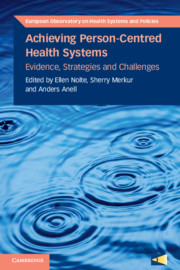Modern medicine has contributed to tremendous achievements in terms of expanding life expectancy, curing diseases that previously were fatal, finding new ways of alleviating pain and suffering, and improving patients’ quality of life. However, when we ask patients about their experiences of the health services they use, the results are not always as positive. Patients do not always feel that they have been respected and listened to, that their needs and preferences have been taken into account and that their experiences and knowledge are valued.
Studies that compare patients’ experiences in different countries show us that some countries are ahead when it comes to delivering health services that are person-centred. Person-centred care essentially entails services where patients feel that they are treated as persons, with respect and dignity, and that their needs, wants and preferences are considered. It is therefore of great value to explore how different countries, and providers in these countries, have attempted to change the way they deliver health care. The Swedish Agency for Health and Care Services Analysis has collaborated with the European Observatory on Health Systems and Policies in an attempt to shed light on possible strategies that can contribute to making our health systems more person-centred. This work rests on the assumption that it is not enough to increase person-centredness in the patients’ interaction with nurses, doctors and other health professionals, but that all tiers of the health system need to consider the perspective of the user and the wider public. Managers and policy-makers at different levels need to create incentives, eliminate obstacles and show leadership in order to create services that will meet individuals’ varying needs and include them in the care process. This volume has brought together some of the most experienced researchers in the field, coming from a range of disciplines, in order to outline and analyse what we know of the effectiveness of different strategies that could contribute to transforming our health systems.
Respecting patients’ wants and preferences, and involving them in the care they receive, can potentially lead to better medical results. More research is, however, needed in this area to create a more comprehensive understanding of the effects of person-centred care. What is more, and perhaps more importantly, person-centredness should be seen as an important value in its own right. The process of participation, in its many different forms, has an intrinsic value as a democratic principle.
Involving patients in their own care, and in designing the health services they use, is a much overlooked resource that we, in light of the pressures our health systems face, can no longer afford to ignore. Learning from patients and their families and letting their voices be a core feature when we design, reform and evaluate our health systems sends an important message to both health professionals and policy-makers. This book can guide and inspire decision-makers, nationally, regionally and locally, in their attempts to create sustainable and inclusive health systems.
We want to thank the Observatory and the World Health Organization for this collaborative process. We are also grateful to the authors of the different chapters and to the editors for their hard work, and we lastly send our thanks to all other participants who have contributed to the book. As a next step, we intend to summarize the most important lessons from the anthology and analyse them in the context of the Swedish health system – thus hoping to increase knowledge and capacity among Swedish policy-makers.

